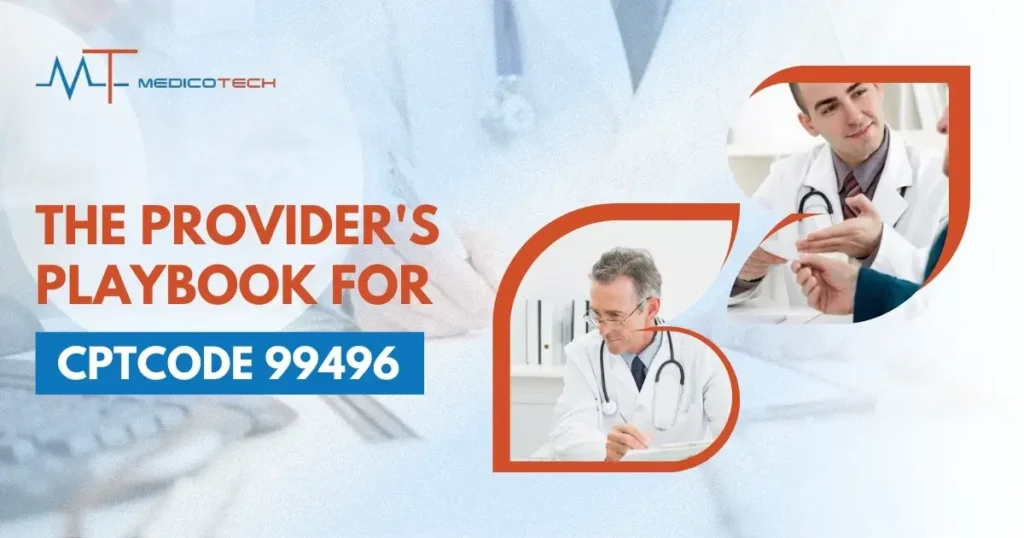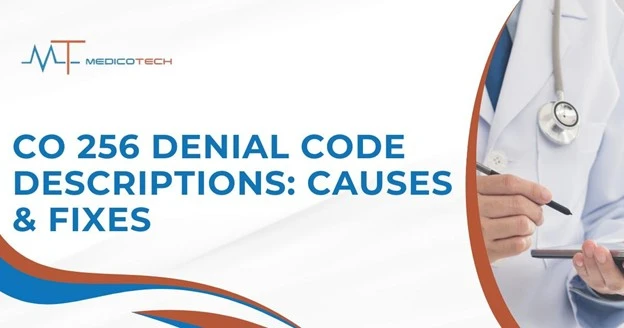Recovering from a hospitalization doesn’t stop when a patient is discharged. Many still have medical issues or social challenges that could cause them to return to the hospital. CPT Code 99496 assists providers in addressing these challenges through TCM (transitional care management) services CPT Code 99496. If addressed in a timely manner, patient outcomes can improve and the chances of being readmitted to the hospital can decrease.
What is CPT Code 99496?
CPT Code 99496 is used when a patient leaves the hospital, a rehabilitation center or a skilled nursing facility and is transitioning to the home or other community setting. This type of care is referred to as ‘Transitional Care Management perman services with “high-complexity medical decision-making” as indicated with the CPT 99496 code. It is performed when a patient is discharged from one of the aforementioned inpatient facilities and is used as a bridge to the patient’s community setting.
Coordinated care in this case is defined as active patient management employed on a proactive basis. There is still the need to undertake and fulfill other tasks that include urgent proactive communication to and the establishment of a treatment plan with the patient that shall see them being visited face to face with the medical personnel within a week. The medical personnel in question remains responsible for the management of the patient’s psychosocial and medical challenges in a timely and efficient manner for the duration of 30 days.
Importance of Transitional Care Management (TCM) Services
The purpose of Transitional Care Management is to fill in the coverage “gaps” in the service areas between one’s home and the hospital. When discharged, many patients have some types of confusions with regards to medications, appointments, and follow-up care. This can lead to re-admittance and complex complications. Providers receive reimbursement under CPT 99496 and also provide a structured care model with documented evidence of offering these services that:
- Reducing the chances of hospital readmission.
- Bettering patient safety while increasing patient satisfaction.
- Better overall care integration.
- Providing additional assistance for the patients’ families and caregivers during the process.
Key Components of CPT Code 99496
Patient Setting: Community Transition from Inpatient
CPT 99496 is applicable when a patient in acute care hospital, or a rehabilitation or a psychiatric or a skilled nursing facility moves to the community, that is, goes home or to a domiciliary or an assisted living facility. This is commnonly the most ‘weak’ part of a patient’s ‘journey’ in the ongoing care system.
Service Period: The 30-Day TCM Service Period
The 30-day service period starts at the time of his or her discharge and is applicable for the next 29 days. All follow up activities and communication and care coordination done during this time period are the services covered under CPT 99496.
Medical Complexity: High-Complexity Medical Decision Making
CPT 99496 will only describe the thinking processes of a decision of high complications as including:
- Multiple chronic conditions.
- Substantial ambiguities to be discriminately diagnosed.
- A high risk of being readmitted or suffering complications, both of which would be serious for any patient.
- Complicated medicine administration.
Key Services Provided Under CPT Code 99496
Non Face to Face Communication
Within two business days of discharge, the provider (or clinical staff under supervision) must make direct contact with the patient or caregiver. This communication can be by phone, email, or another electronic method.
Purpose:
- Confirm the patient’s status.
- Review discharge instructions.
- Address immediate concerns.
- Reinforce follow-up care steps.
A critical aspect of CPT 99496 is the requirement for a face-to-face visit within 7 calendar days of discharge. This visit is essential for early detection of complications and to reaffirm the care plan, preventing issues from escalating. The 7-day timeframe is key in ensuring proper care and is an important condition for proper CPT 99496 billing. Failure to meet this requirement can also result in a 96 denial code if not appropriately documented and carried out.
Face-to-Face Visit: Importance of Post-Discharge Visit Within 7 Days
A face-to-face visit is mandatory within 7 calendar days of discharge for CPT 99496 billing. This timely check-in ensures early identification of complications and reinforces the care plan before issues escalate.
Care Plan Creation and Revision: Tailored to Post-Discharge Needs
Providers must review the patient’s discharge summary and create or update a personalized care plan. This plan addresses:
- Medication management.
- Symptom monitoring.
- Lifestyle or dietary adjustments.
- Referrals and follow-up appointments.
Review of Discharge Documents: Continuity of Care
The provider cross-checks all discharge documents, results, and medication lists to ascertain what ongoing treatment can be done within the specific guidelines of what the hospital has maintained. This ensures the avoidance of hazardous mistakes such as duplicate therapy or treatment contradictions.
Working with Other Members of the Healthcare Team: Comprehensive Care
During transitional care, there is a need to collaborate with the primary care physician, specialists, pharmacist, therapists, and social workers. This collaboration is multi-disciplinary and is considered a part of the value of the CPT 99496 code.
Education of Patients and Family: Education for Care After Discharge
Recovery cannot occur in the absence of education. Understanding medication instructions, warning signs, and when and where to seek follow-up care is the responsibility of healthcare workers.
Health outcomes as well as better confused outcomes are achieved through family empowerment.
Community Resources and Other Specialists: Community Specialists
In the case of many patients, recovery is dependent on referrals to community specialists as well as resources like home health services, and social support. Providers work to make these resources and specialists available to patients to enhance the recovery process.
High Complexity Medical Decision Making
When High Complexity is Needed
In the case of CPT code 99496, the need for High-Complexity Medical Decision Making stems from considerable challenges or risks involved in the case. These include the pertinent factors of the patient’s overall health state, chronic health challenges, and possible complications after the patient is discharged.
In these situations, High-Complexity Medical Decision Making is needed most:
- There are several medical problems that need to be treated at the same time.
- There are significant diagnostic t.ouble(s) that need to be resolved.
- There is high risk of negative consequences, such as readmission, or possible decline of the patient’s condition.
- There are serious psychosocial problems, especially related to mental health, such as substance abuse, or little to no social support.
Identifying Patients at High Risk for Readmission
During the post-discharge period, patients at high risk of readmission need to be managed closely. These patients commonly have:
- Multiple comorbidities such as diabetes, heart disease, or COPD.
- Complicated recoveries from hospitalizations or surgeries.
- Multiple hospitalizations during the previous year, suggesting a decline in their health status.
- Old age, which is usually correlated with frailty and polypharmacy.
- Weak social support, lack of transportation, or other social determinants of health, which affect access to follow-up care.
Identifying patients early in the discharge process allows the optimal allocation of healthcare resources to prevent complications and provide the adequate level of care.
CPT Code 99496 vs CPT Code 99495
Distinction Between 99495 and 99496
Despite both being classified under Transitional Care Management (TCM), the essential difference between CPT 99495 and CPT 99496 is the level of complexity in the decision-making process.
- CPT Code 99495: This code is for instances when the decision-making process is of moderate complexity and is ideal for patients who will require less intervention and lower levels of decision-making than those patients being billed under CPT 99496.
- CPT Code 99496: This code is for high complexity and is used when the patient has a complex medical or psychosocial issue, there is a high likelihood of the patient being readmitted, or there is extensive care coordination needed in the post-discharge period.
Moderate vs High Complexity
The complexity of medical decision-making is categorized by the following factors:
- Moderate Complexity (99495):The decision-making complexity class that is “Moderate Complexity (99495)” is when care involves the management of one or more chronic conditions at the “Moderate” level, has less involved care, and the risks are “Moderate.”
- High Complexity (99496): This level involves complex decisions, potentially with several high-risk conditions. There’s significant diagnostic uncertainty, and the patient may need intensive care coordination to avoid complications or readmission.
Complexity is the factor that tells which CPT code to use. For CPT 99496, high-complexity cases include advanced chronic conditions, several hospital stays, and high levels of medical resources and treatments needed.
Use of Each Code
- CPT 99495 could be used for patients whose conditions are somewhat easier to manage with some middle level of care, such as not fully controlled diabetes or hypertension, and a low to middle level of risk for readmission.
- CPT 99496 is used for patients needing complex decision-making due to high-risk conditions such as recent surgical procedures, several comorbid conditions, or having psychiatric and social issues related to recovery.
Importance of Transitional Care Management
Reducing Readmissions and Improving Patient Outcomes
Transitional Care Management services as per CPT code 99496 is crucial to avoid readmissions. It is important that patients are not only following the planned care post hospital discharge but are also educated about the complications that could arise and how to manage them.
By promptly engaging with patients post discharge, healthcare providers can:
- Make sure that patients comprehend how to take their medications, as well as their potential side effects or associated risks.
- If needed, help organize follow-up care with specialists to ensure that patients do not have to be readmitted.
Benefits for Healthcare Providers and Patients
Both healthcare providers and patients gain considerably from CPT code 99496.
- For Healthcare Providers:
- Healthcare providers can be paid for the important services that they provide during the post-discharge period.
- It solidifies the bond between providers and patients, demonstrating that providers care about their patients and their recovery after leaving the hospital.
- It helps avoid penalties for readmissions, especially under value-based care arrangements.
- For Patients:
- Improves health outcomes by minimizing the risk of complications and readmissions.
- Provides ongoing care coordination, addressing all dimensions of the patients’ health physical, mental, and social.
- Improves patient satisfaction with follow-up care, effective communication, and transitions that are easy to navigate.
Billing and Reimbursement for CPT Code 99496
How to Bill for CPT Code 99496
Billing for CPT code 99496 requires careful attention to the specific services provided during the 30-day TCM service period. The key steps include:
- Documenting high-complexity decision-making and the medical necessity of services provided.
- Confirming patient eligibility for TCM services under the provider’s contract.
- Ensuring that the patient received timely follow-up care, including non-face-to-face and face-to-face visits.
Accurate documentation of these components is essential to ensure that the billing is compliant and eligible for reimbursement.
Insurance and Coverage Considerations
Coverage for CPT 99496 will depend on the patient’s plan and the insurance provider. Most Medicare and Medicaid programs will cover transitional care management, but private insurance may come with extra requirements. Prior to rendering services, make sure to confirm with the insurance provider to minimize unexpected out-of-pocket expenses to patients.
Summary
CPT code 99496 covers Transitional Care Management (TCM) services that involve high-complexity medical decision making for patients discharged from an inpatient setting (such as a hospital or rehabilitation center) to a community setting, like home or assisted living. This 30-day service period starts on the discharge date and includes essential follow-up care, such as communication with the patient or caregiver within two business days and a face-to-face visit within 7 days. High-complexity decision making is necessary when a patient has multiple chronic conditions, high risk of readmission, or significant diagnostic uncertainty. Identifying patients at high risk of readmission helps prevent complications and reduces unnecessary hospital readmissions. CPT 99496 differs from CPT 99495, which applies to moderate-complexity cases, by requiring a higher level of decision making and care coordination. TCM services like those covered by CPT 99496 are crucial for improving patient outcomes, reducing readmissions, and enhancing satisfaction by providing structured follow-up care. Billing for these services requires careful documentation of the provided care, including non-face-to-face communication and the required face-to-face visit. Insurance coverage for TCM can vary, so it’s important to verify eligibility with insurers. Accurate coding ensures healthcare providers are reimbursed for these essential services, ultimately supporting better patient care and recovery.
FAQS
What is CPT code 99496?
CPT code 99496 is used for Transitional Care Management (TCM) services that involve high-complexity medical decision making for patients discharged from an inpatient setting to a community setting, such as their home or an assisted living facility. These services include timely follow-up care, non-face-to-face communication, and a face-to-face visit within 7 days of discharge.
What does high-complexity medical decision making mean?
High-complexity decision making involves managing patients with multiple chronic conditions, high diagnostic uncertainty, significant risk of readmission, or complex medical and psychosocial needs. These cases require intensive coordination and careful assessment before making clinical decisions.
How long does the service period for CPT 99496 last?
The service period for CPT 99496 lasts 30 days, starting on the date of discharge from the inpatient setting. This includes non-face-to-face communication with the patient or caregiver and a face-to-face visit within 7 days.
What is the difference between CPT code 99496 and CPT 99495?
CPT code 99496 is used for high-complexity cases that require intensive care coordination and high-level decision making, whereas CPT 99495 is for moderate-complexity cases, where the patient’s medical needs are less complex.




